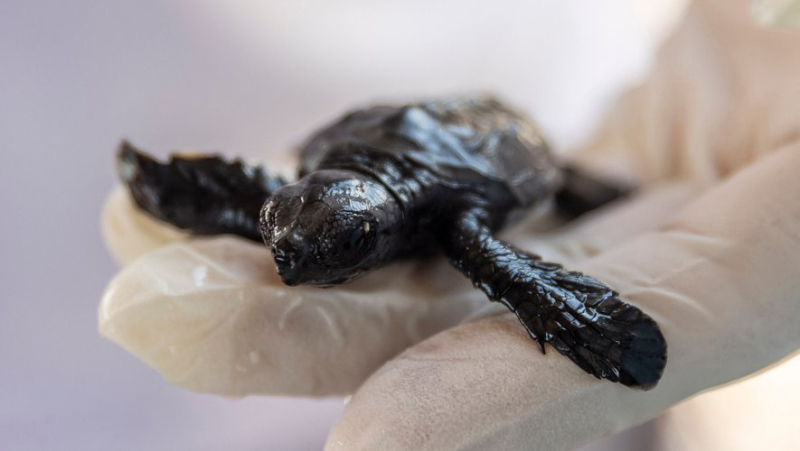“It’s up to us to learn to live in harmony with nature”: the baby boom of sea turtles on the Turkish coasts

These marine reptiles are included on the red list of threatened species of the International Union for Conservation of Nature (IUCN). KEMAL ASLAN/AFP
Sometimes helped by volunteers to crack their shells, baby turtles attack life with a first challenge: reaching the water bathed by the moon on a Turkish beach in the Mediterranean.
The journey promises to be uncertain and only one child in a thousand will survive until adulthood and then return to the sand where they were born to lay eggs there, 25 years later.
The number of nests has doubled this year on the Turkish coasts to reach 700 in the locality of Manavgat alone (south), east of Antalya: proof that despite threats, protection measures bear fruit.
A group of volunteers watches over this stretch of coastline, a 10 km tourist site nestled at the foot of the mountains, popular for its golden sand and clear waters, which is also a breeding area for Caretta caretta , commonly called Loggerhead turtles.
These marine reptiles are listed on the International Union for Conservation of Nature (IUCN) Red List of Threatened Species.
"Our average estimate for this year is about 60,000 eggs, of which 30,000 will hatch into baby reptiles. Only 30 of them will return here in years,” Seher Akyol, the founding president of the Dekafok marine conservation center, told AFP.
Red light and signs
Turkey's southern coast is home to 21 official nesting areas, where most beaches are off-limits from 8 p.m. to 8 a.m. to give the turtles free rein, but Manavgat is not one of them.
Hence the presence of Turkish and foreign student volunteers who mark the nests, surround them with sticks and collect waste on the beach, in order to shelter the eggs from bathers. At night, they patrol and dig nests to help some baby turtles break their shells and reach the sea.
Local authorities support these initiatives: the mayor of Manavgat has placed red light street lights along coastal roads. Signs are also posted on the beach, reminding in four languages that the law penalizes nearly 390,000 Turkish liras (approximately 10,700 euros) for any damage caused to the nests.
"We seek the advice of scientists and environmentalists on what we should do to protect turtles and we implement their advice", assures the mayor, Niyazi Nefi Kara. "It's up to us to learn to live in harmony with nature.& ;quot;
Seher Akyol welcomes this change in mentality. "Some residents feared the beach would be closed. But people and Caretta caretta can live together", she maintains.
"Since we know where they are thanks to the signs, we do our best not to encroach on their living space", assures Songul Sert, 33 years old, in the middle of a picnic with his family.
Climate change
Caretta caretta, which weigh 90 to 180 kilos, live up to 80 years. "The number of eggs and hatchings may seem high, but the number of turtles able to return to lay eggs on land after 25 years is extremely limited. This is why they are in danger", insists Professor Mehmet Cengiz Deval, of Akdeniz University in Antalya.
This sea turtle is found mainly in the subtropical and temperate regions of the Atlantic, Pacific and Indian Oceans, as well as in the Mediterranean. The IUCN considers the Mediterranean Caretta caretta to be “least concern”, but the species remains vulnerable globally.
Climate change is also a threat, the sex of newborns being determined by the temperature of the sand: coolness favors males and heat, females.
"The average nest temperature is 32-33 degrees Celsius from July onwards, which means most babies are female", explains Professor Deval.
"If this trend continues, within 30 to 40 years, females will be in the majority but will no longer have male partners to reproduce. This is the greatest danger, he warns.
Seher Akyol, who dedicated his life to the preservation of turtles and dreams of a center to care for injured specimens, evokes "their look when they reach the water". "You're going to take me for a crazy woman, but I swear they seem to be expressing their gratitude."




